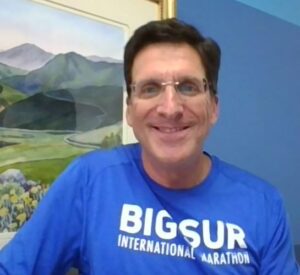By Doug Thurston, World Athletics/AIMS Level A Measurer
If you are a new race director or direct a smaller race, perhaps you have been asked if your course is “certified.” It must be important if potential entrants are asking about it, right? YES: in almost every case, having your course certified IS important. It’s a basic expectations most runners have when they enter your race. Your entrants want to know the course distance is correct so they can compare their time to other races they have run and maybe even qualify for another race like the Boston Marathon or even the Olympic Marathon Trials. Certifying your racecourse(s) may also differentiate your race from other local events, helping to attract more runners and contribute to your race’s reputation as an event that sweats the details.
Getting your course certified may sound complicated and more than a little intimidating, but the process is relatively simple. You can take on the project yourself if you are comfortable riding a bicycle and doing simple math. Or, you can hire a local measurer, provide him or her detailed information and options, and let them take care it all for you.
Here are the basic components of the course certification process:
• All certified courses are measured using the same equipment and methods, from your neighborhood 5 km to the largest races around the world.
• The measuring is done on a standard bicycle fitted with a calibrated, mechanical counter on the front wheel.
• The measurer calibrates his bicycle before and after each measurement session on a set course that has been carefully measured with a steel tape or laser (usually 1,000-feet or 300-meters), does some basic math to determine how many counts on the counter equals a mile, a kilometer, and the total desired course distance.
• The measurer then rides the course as it will be set-up and available to the runners on race day. This often means riding very early in the morning when traffic is lighter and/or having a police escort.
• The measurer aims to ride the shortest possible route that will be available to runners, cutting the tangents by straightening out corners, etc. Wherever the runners are able to go on race day, the measurer will try to go with his bike.
• There are multiple techniques when measuring to cover the distance as accurately and safely as possible. These often include riding a straight section on a safer side of the street with traffic, riding some sections in the opposite direction the runners will go, “offsetting” around a problematic situation (like parked cars, delivery vans, construction, locked gates, etc.).
• The measurer usually needs to know where they can adjust the course to get the distance spot on: can the start or finish be moved? What about a turn-around? Can a short out-and-back be added? What other options are available?
• As you can read in the sidebar about GPS, most courses laid out online will be short when actually measured on a bicycle. If I am measuring a half marathon, for example and the race director has sent me a link to the course on an online program like Mapmyrun.com, it needs to be at least 1% longer to come out right as actually measured.
• A certified course can be slightly long but it can’t be short. For example, I have measured several courses that may be 50 or so feet too long but the race director wants to keep the start and finish at a certain place and there was no practical way to take out such a short distance. And one recent race director decided to accept a long 5 km rather than adjust the start or finish that was used for an accompanying longer race. In this instance, they told the runners up front that it’s actually a 5.19 km race or about 190 meters or 623 feet longer than a “regular” 5 km. If the timing company knows this ahead of time, they can reconfigure their results program to compute the pace per mile or kilometer for each finish based on the actual distance run, which runners will appreciate.
• Once the measurer gets the course correct, marks the start, finish, all of the miles, kilometers, or other intermediate marks the race director needs (with accurate narration), the paperwork and map will be submitted for certification. The measurer will compute the altitude at the start and finish as well as the highest and lowest parts of the course and the separation between the start and finish, if any. These datapoints help identify if a course is eligible for records or, in some cases, qualifying for other events.
• The measurer submits all of the data and map to the state or regional certifier who approves the course, stamps the map with the certification number, and uploads it to the USA Track and Field (and in some cases World Athletics) websites and databases. The certified course is now visible to the general public. Certified courses are listed on the resources section of the USA Track and Field website: https://www.usatf.org/resources/course-certification.
• If you want to read more about the process of certification to tackle the tasks yourself, find a measurer in your area who you can pay to measure, or just review some course maps in your area, visit the same site listed above.
• Note that certified courses are in the public domain. It’s not unusual for one race to use the same certified course as another event, particularly if it’s in a local park that hosts multiple races a year. You can search for existing certified courses in your area on the USATF site.
A few other notes:
• Your course is good for 10 years if there are no changes due to construction, etc. All courses expire after 10 years and need to be remeasured and recertified even if there have been no changes to the roads.
• Certain higher-profile events affiliated with World Athletics, AIMS (Association of International Marathons and Road Races), or the Abbott World Marathon Majors Age Group standings are remeasured every five years.
• Measurers set their own fees and expenses. There are no industry standards, minimums, or maximums. If you want to hire someone to do the work, be sure and understand their complete rate structure in advance including any travel and expenses as well as payment policies (some may want advance payment; others will invoice when they finish all of the maps and paperwork).
• The measurer will provide a map with detailed descriptions and maps of the start, finish, and the course locations/mile marks you asked to be measured. The race director should review the course and all markings to make sure they understand how the course was measured so it can be set up correctly on race day.
• Many race directors’ contract with the measurer before the race to refresh the mile marks and, on race day, some measurers are retained to work with the course operations team, traffic control company, etc., to make sure the course is set up correctly on race day, and/or ride in a lead vehicle to attest to course accuracy, etc. It’s customary to compensate a measurer for this extra work.
I hope this article has provided some useful information about the importance of certifying your race course(s) and some insight into the process. Additional web searches will bring a ton more data. I think you will find the measurement community very welcoming and helpful: after all, we believe what we do is a valuable part of the total race experience and we want to help your race succeed.
Good luck and safe running and race directing.
About the Author
 Doug Thurston is a World Athletics/AIMS Level A measurer and has certified more than 100 courses throughout the country. He has also been a race director for 40 years managing races large and small including the Tulsa Run, Columbus Marathon, and the Big Sur International Marathon. He continues to measure courses and consult and assist with course and race operations from his home in Santa Fe, New Mexico. He can be reached at tallrunnerdoug@gmail.com.
Doug Thurston is a World Athletics/AIMS Level A measurer and has certified more than 100 courses throughout the country. He has also been a race director for 40 years managing races large and small including the Tulsa Run, Columbus Marathon, and the Big Sur International Marathon. He continues to measure courses and consult and assist with course and race operations from his home in Santa Fe, New Mexico. He can be reached at tallrunnerdoug@gmail.com.
Sidebar One: Having a certified course is not the same as having a sanctioned event. The terms are often confused but they are not interchangeable. An event sanction is issued by your local USA Track and Field association after you have completed an application and agree your event will meet USATF’s minimum standards for medical and public safety, awards, timing and other basic race essentials. A certified course means your course has been successfully measured and you have a course identification number.
Sidebar Two: GPS devices are NOT used to measure and certify courses. They are worn by many of your runners, though, and, in my experience, GPS devices almost always over-estimate the race distance by at least one percent, or about 50 feet per mile. For example, readings of 13.25 miles or more for a half marathon, for example, or 26.5 +/- for a full marathon are not uncommon. Besides their wearable technology being off a bit, most runners also don’t run the shortest line around the course and often add a little here and there when they get a cup of water, use the restroom, or because of crowding from other runners on the course. I always have a Garmin GPS unit on my handlebars when I measure a course. It’s handy to let me know when I’m coming up to a mile marker and provides good waypoints for mile markers. But 99 times out of 100, it will show me coming to a mile before the computed distance on the mechanical counter. You can find examples of language you might want to use to explain this to curious runners at http://legacy.usatf.org/Products-/-Services/Course-Certifications/USATF-Certified-Courses/Certify-Your-Course/Statement-on-GPS-Use-by-Runners.aspx. And here is a second article with additional great information: https://runningonhappy.com/2017/06/gps-accuracy-race-course-distances/

